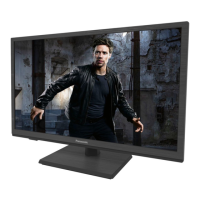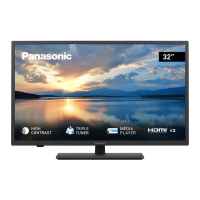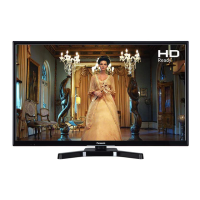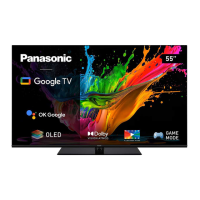Do you have a question about the Panasonic TX Series and is the answer not in the manual?
Guidelines for servicing procedures, ensuring safety and proper installation of protective devices.
Procedure for measuring touch current to prevent shock hazards, including network setup and limit values.
Recommendations for specific types of lead-free solder alloys suitable for purchase and use.
Diagram showing the physical placement and identification of major circuit boards within the TV chassis.
Step-by-step instructions for detaching the TV's pedestal stand using screws.
Instructions for removing the rear cover of the TV set, including screw identification and removal steps.
Instructions for safely removing the LCD panel from its packaging with protection sheets.
Guidelines for safely transporting the LCD panel, emphasizing proper support and handling techniques.
Specific warnings against improper handling of the LCD panel, such as gripping or protruding from a table.
List of supported video signal formats for Component and HDMI inputs, including refresh rates and resolutions.
Details on various input/output ports including HDMI, USB, Ethernet, and Wireless LAN specifications.
Information on specific ICs requiring replacement and their corresponding part numbers or new versions.
Details of MTK key data, including CI+ versions, HDCP compliance, and DRM support for specific models.
Table listing test points on A-board and P-board with expected voltage values for verification.
Procedure to navigate the TV menu to display software version and model information.
Details on the Hotel Mode setup menu, including parameters like Initial Input, Volume, Button Lock, and Quick Start.
Steps to prepare a USB memory stick with a startup file (hotel.pwd) for data copying.
Procedure to copy TV settings and channel scan data to a USB memory stick using a password.
Procedure to copy data from a USB memory stick to the TV set, requiring a password for initiation.
Instructions for initiating self-checks and a table mapping display components to their reference numbers and PCB locations.
Chart detailing power LED blinking patterns, corresponding fault codes (SOS), and potential defective blocks.
Procedure for activating the LCD panel test mode and methods for diagnosing panel or A-board faults.
Diagram illustrating the interconnection pathways and connector mappings between major circuit boards.
Block diagram of the A-board, detailing integrated circuits, power management, and signal paths.
Block diagram illustrating connections and signal flow for P-board, GK-board, and K-board components.
Diagrams showing the physical locations of various parts and screws on the rear of the TV and its stand.
Diagrams illustrating the physical locations of internal components such as PCBs, remote control, and cables.
Diagrams illustrating the pathways and connections of internal wiring harnesses throughout the TV.
Diagrams showing the precise placement of heat rubber and aluminum tape components on the A-PCB for thermal management.
Diagrams illustrating the placement of heat rubber and gaskets on the A-PCB for thermal management and sealing.
Diagrams showing the placement of heat rubbers on the A-PCB and the heatsink for effective thermal dissipation.
Diagrams illustrating the placement of gaskets on the A-PCB for sealing and vibration dampening.
Exploded view illustrating the arrangement of components and protective materials used in the TV packaging.
Explanation of abbreviations used for resistors and capacitors, including their types and tolerance values.
Comprehensive list of replacement parts with part numbers, descriptions, quantities, and remarks for specific TV models.
Notes on resistor, capacitor, and coil units, test points, earth symbols, and voltage measurement conditions.
Schematic section of the A-board covering IIC-BUS, Adjust-Develop interfaces, and TCON connections.
Schematic section of the A-board detailing the HDMI input interfaces, including signal and power connections.
Schematic section of the A-board showing HDMI 3 interface details and signal routing to other components.
Schematic section of the A-board detailing the YUV, V/A-IN, and Audio input circuits and their connections.
Schematic section of the A-board covering pin termination, JTAG, and UART interfaces for debugging and configuration.
Schematic section of the A-board detailing the Common Interface (CI) connector and its associated circuitry.
Schematic section of the A-board showing the audio amplifier circuit, including connections to speakers and other audio components.
Schematic section of the A-board detailing the timing controller (TCON) connections and interface to the LCD panel.
Schematic section of the A-board detailing P-A and A-K connector interfaces, and the temperature sensor circuit.
Schematic section of the A-board detailing the eMMC memory and IC8920 connections, vital for storage and firmware.
Schematic section of the A-board detailing the Ethernet PHY, USB 2, and USB 3.0 interfaces and their circuitry.
Schematic section of the A-board detailing power supply circuits, voltage regulators, and memory interfaces like EMMC.
Detailed pinout assignments for various interfaces on the A-board, including LOCK/WIKING, tuner, and USB.
Schematic section of the A-board detailing DDR3 memory interfaces and associated power rails (STB3.3V, STB1.5V).
Schematic section of the A-board detailing power supply and regulator circuits for the LOCK/HORNBILL function.
Schematic section of the A-board providing detailed connections and configurations for DDR3 memory modules.
Schematic section of the A-board showing detailed connections for DDR3 memory modules.
Schematic section of the A-board covering tuner circuitry, LNB power, and the power factor correction (PFC) stage.
Schematic section of the P-board detailing the power factor correction (PFC) circuit and AC power input stage.
Schematic section of the P-board covering the main power supply circuits and hot/cold circuit isolation.
Schematic section of the P-board detailing various power supply and voltage regulator circuits.
Schematic diagram of the K-board, showing interface connections to other boards and control circuitry.
Schematic diagram of the GK-board, illustrating keypad interface and control signal connections.
Top side conductor pattern view of the A-Board PCB, showing component footprints and trace layout.
Bottom side conductor pattern view of the A-Board PCB, revealing traces and component placement.
Top side conductor pattern view of the P-Board PCB, showing components and trace layout.
Bottom side conductor pattern view of the P-Board PCB, showing components and trace layout.
Top side conductor pattern view of the K-Board PCB, showing components and trace layout.
Top side conductor pattern view of the GK-Board PCB, showing buttons and interface layout.
Guidelines for servicing procedures, ensuring safety and proper installation of protective devices.
Procedure for measuring touch current to prevent shock hazards, including network setup and limit values.
Recommendations for specific types of lead-free solder alloys suitable for purchase and use.
Diagram showing the physical placement and identification of major circuit boards within the TV chassis.
Step-by-step instructions for detaching the TV's pedestal stand using screws.
Instructions for removing the rear cover of the TV set, including screw identification and removal steps.
Instructions for safely removing the LCD panel from its packaging with protection sheets.
Guidelines for safely transporting the LCD panel, emphasizing proper support and handling techniques.
Specific warnings against improper handling of the LCD panel, such as gripping or protruding from a table.
List of supported video signal formats for Component and HDMI inputs, including refresh rates and resolutions.
Details on various input/output ports including HDMI, USB, Ethernet, and Wireless LAN specifications.
Information on specific ICs requiring replacement and their corresponding part numbers or new versions.
Details of MTK key data, including CI+ versions, HDCP compliance, and DRM support for specific models.
Table listing test points on A-board and P-board with expected voltage values for verification.
Procedure to navigate the TV menu to display software version and model information.
Details on the Hotel Mode setup menu, including parameters like Initial Input, Volume, Button Lock, and Quick Start.
Steps to prepare a USB memory stick with a startup file (hotel.pwd) for data copying.
Procedure to copy TV settings and channel scan data to a USB memory stick using a password.
Procedure to copy data from a USB memory stick to the TV set, requiring a password for initiation.
Instructions for initiating self-checks and a table mapping display components to their reference numbers and PCB locations.
Chart detailing power LED blinking patterns, corresponding fault codes (SOS), and potential defective blocks.
Procedure for activating the LCD panel test mode and methods for diagnosing panel or A-board faults.
Diagram illustrating the interconnection pathways and connector mappings between major circuit boards.
Block diagram of the A-board, detailing integrated circuits, power management, and signal paths.
Block diagram illustrating connections and signal flow for P-board, GK-board, and K-board components.
Diagrams showing the physical locations of various parts and screws on the rear of the TV and its stand.
Diagrams illustrating the physical locations of internal components such as PCBs, remote control, and cables.
Diagrams illustrating the pathways and connections of internal wiring harnesses throughout the TV.
Diagrams showing the precise placement of heat rubber and aluminum tape components on the A-PCB for thermal management.
Diagrams illustrating the placement of heat rubber and gaskets on the A-PCB for thermal management and sealing.
Diagrams showing the placement of heat rubbers on the A-PCB and the heatsink for effective thermal dissipation.
Diagrams illustrating the placement of gaskets on the A-PCB for sealing and vibration dampening.
Exploded view illustrating the arrangement of components and protective materials used in the TV packaging.
Explanation of abbreviations used for resistors and capacitors, including their types and tolerance values.
Comprehensive list of replacement parts with part numbers, descriptions, quantities, and remarks for specific TV models.
Notes on resistor, capacitor, and coil units, test points, earth symbols, and voltage measurement conditions.
Schematic section of the A-board covering IIC-BUS, Adjust-Develop interfaces, and TCON connections.
Schematic section of the A-board detailing the HDMI input interfaces, including signal and power connections.
Schematic section of the A-board showing HDMI 3 interface details and signal routing to other components.
Schematic section of the A-board detailing the YUV, V/A-IN, and Audio input circuits and their connections.
Schematic section of the A-board covering pin termination, JTAG, and UART interfaces for debugging and configuration.
Schematic section of the A-board detailing the Common Interface (CI) connector and its associated circuitry.
Schematic section of the A-board showing the audio amplifier circuit, including connections to speakers and other audio components.
Schematic section of the A-board detailing the timing controller (TCON) connections and interface to the LCD panel.
Schematic section of the A-board detailing P-A and A-K connector interfaces, and the temperature sensor circuit.
Schematic section of the A-board detailing the eMMC memory and IC8920 connections, vital for storage and firmware.
Schematic section of the A-board detailing the Ethernet PHY, USB 2, and USB 3.0 interfaces and their circuitry.
Schematic section of the A-board detailing power supply circuits, voltage regulators, and memory interfaces like EMMC.
Detailed pinout assignments for various interfaces on the A-board, including LOCK/WIKING, tuner, and USB.
Schematic section of the A-board detailing DDR3 memory interfaces and associated power rails (STB3.3V, STB1.5V).
Schematic section of the A-board detailing power supply and regulator circuits for the LOCK/HORNBILL function.
Schematic section of the A-board providing detailed connections and configurations for DDR3 memory modules.
Schematic section of the A-board showing detailed connections for DDR3 memory modules.
Schematic section of the A-board covering tuner circuitry, LNB power, and the power factor correction (PFC) stage.
Schematic section of the P-board detailing the power factor correction (PFC) circuit and AC power input stage.
Schematic section of the P-board covering the main power supply circuits and hot/cold circuit isolation.
Schematic section of the P-board detailing various power supply and voltage regulator circuits.
Schematic diagram of the K-board, showing interface connections to other boards and control circuitry.
Schematic diagram of the GK-board, illustrating keypad interface and control signal connections.
Top side conductor pattern view of the A-Board PCB, showing component footprints and trace layout.
Bottom side conductor pattern view of the A-Board PCB, revealing traces and component placement.
Top side conductor pattern view of the P-Board PCB, showing components and trace layout.
Bottom side conductor pattern view of the P-Board PCB, showing components and trace layout.
Top side conductor pattern view of the K-Board PCB, showing components and trace layout.
Top side conductor pattern view of the GK-Board PCB, showing buttons and interface layout.












